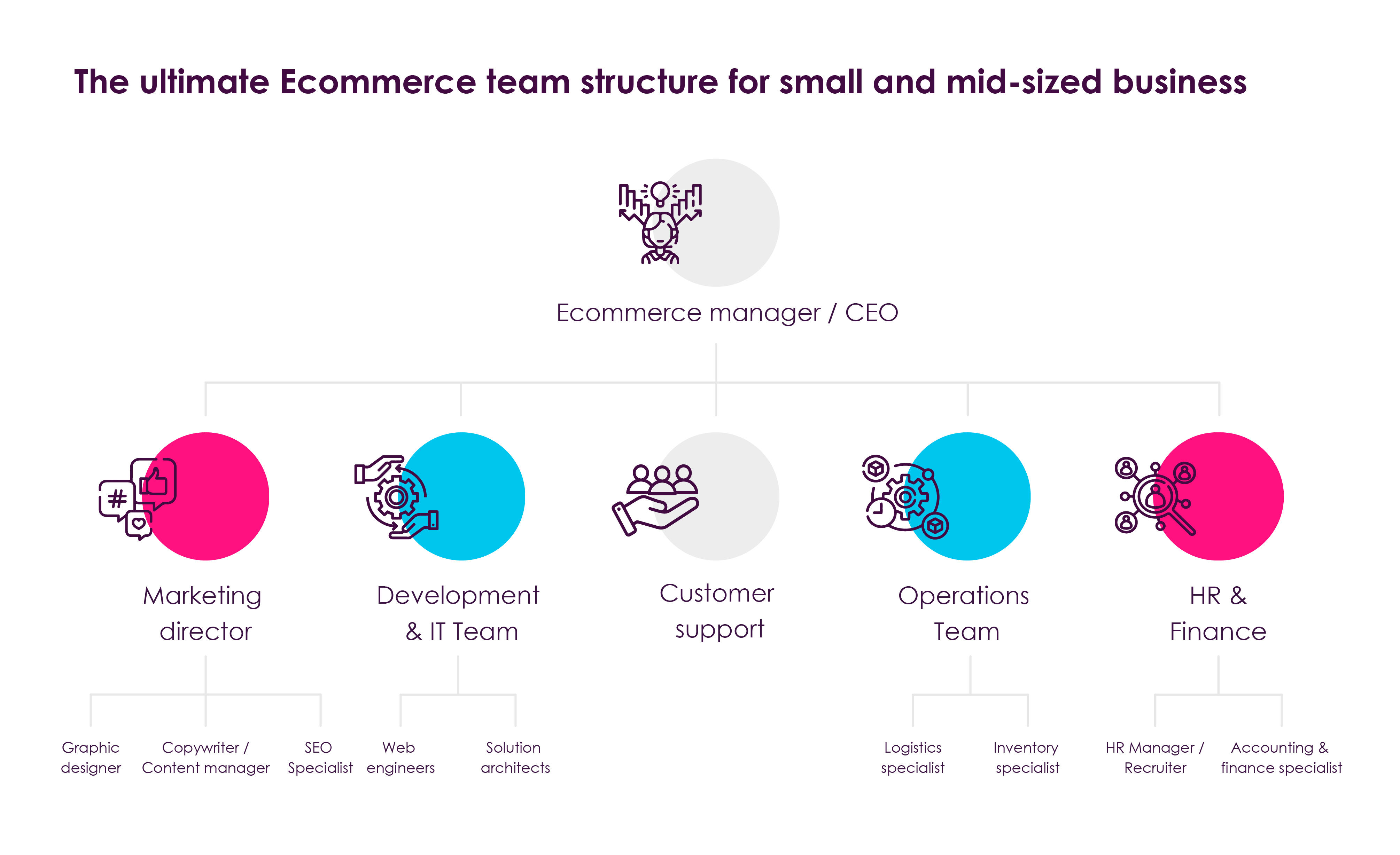As any business owner or leader knows, building out the organisational structure of a company or team is one of the trickiest puzzles to solve. Do it right and the organisation will run smoothly and produce ideal outcomes; do it wrong and things can quickly grind to a halt or implode altogether.
This is also the case when structuring an e-commerce organisation. With the rapid pace of the retail industry and the constant evolution of online sales, it’s crucial to build a division that can be flexible and effective, no matter what may change. In this article, Omnia explores the nuances of the structure of e-commerce businesses, how organisations should approach the topic and where pricing fits into the larger picture.
Structure of the modern e-commerce department
In 2023, the structure of e-commerce departments can vary widely depending on the needs of the business. Each member of the team has a crucial role to play in ensuring the organisation runs smoothly and that customers receive the products they’ve purchased online.
Typically, an e-commerce organisation will have some combination of the following roles:

From the top: E-commerce manager/Director of e-commerce/CEO
The captain of the ship oversees all areas of the e-commerce organisation including marketing management, customer service, product management, KPI tracking, analytics and reporting, and partnership management.
The marketing team
The success of a marketing team can make or break an e-commerce department. Members of this team can include:
- Marketing manager: This person leads the full marketing team. The Marketing Manager is responsible for spreading the word about the products in your online store by analysing and building strategies based on customer data, trends, competitor insights and market changes. They are also responsible for brand building, creative strategy, and multichannel strategy.
- Graphic designer: The designer can take care of all the necessary visuals within the corporate identity (CI), from logos and social media graphics to charts and data visualisations for blog posts or sales materials.
- Content or copy writer: This role is responsible for writing compelling text for product descriptions, website content and marketing campaigns. A successful content writer will also have some level of SEO knowledge to ensure copy is optimised for successful Google search results.
Development and IT team
The website is the beating heart for every e-commerce seller. All e-commerce companies will need developers to build and maintain the company’s website and software systems. The UI/UX designer can also fall under this department. Copy writers will often work closely with UI/UX designers to ensure that the text used on an e-commerce store falls within the brand’s tone and identity.
One of the most important responsibilities for the development and IT team is to optimise the performance of the website across devices, ensuring high availability and uptime so customers aren’t waiting too long for the storefront to load. Another key role is to integrate any chosen third-party services or SaaS solutions, like Shopify or BigCommerce, while ensuring data security and maintaining a structured product catalogue.
Operations team
The ops team’s job is to keep the actual operation of the online store running smoothly from day to day. Some key roles that may be hired for include:
- Logistics manager: This role is responsible for the accurate and timely delivery of supplier orders to the company’s warehouses or directly to consumers’ homes.
- Inventory manager: This team member keeps track of all products being sold by the store, most importantly ensuring that the number of goods displayed as available on the website actually matches the number stored in the warehouse, to avoid any accidental overselling.
- Fulfilment team: Fulfilment teams ensure all orders coming from the website and other channels are correct and complete, then locate the items, pack them for shipment, add shipping labels and work with carriers to get the orders from point A to B.
Supporting departments may include Human resources which plays an important role in growing an e-commerce business, as they recruit, hire and onboard all incoming talent for the business. In addition, a customer care department for shoppers to receive support with questions, complaints and returns.
Examples in practice: New Balance and Fenty Beauty
A number of brands are finding success with a more modern, agile e-commerce organisational structure. New Balance, for example, made some big changes in 2021. “We’ve introduced agile into the entire organisation. We’ve developed 90-day sprints, which have allowed us to put together several building blocks that have accelerated our growth ambitions,” said CEO Joe Preston.
Fenty Beauty, a D2C brand started by singer Rihanna, is another interesting case study. Rather than entering the market on their own like other beauty brands – Kylie Cosmetics, for example – Fenty was created in partnership with LVMH’s Kendo Beauty division. This allowed the brand to launch on a global scale at 1,620 stores in 17 countries almost instantly in 2017, referred to by LVMH as “the first-ever global beauty launch in history.”
Having LVMH as a partner gives Fenty access to global distribution through Sephora, one of the largest omnichannel beauty retailers in the world. This gave the brand quality merchandising and product placement both online and offline right from the start.
The pricing puzzle: Where does pricing fit into the e-commerce equation?
Nothing is written in stone when it comes to pricing, and the “right” answer will be different for every organisation. At Omnia, we have seen pricing sit within a number of departments, depending on the business: Business Analytics, Marketing, Sales or Buying, for example. For more mature organisations, we tend to see pricing within the e-commerce organisation. Within that e-commerce structure, where exactly does pricing fit, and more importantly, who owns responsibility for it?
Having pricing ownership clearly assigned to a specific manager or team ensures the business can meet objectives and nothing falls through the cracks. Operating the pricing platform, especially when using dynamic pricing software where rules are set and pricing can change constantly, is a key role and core to the success of the overall business.
Below, we’ll cover some observations from the Omnia team: The roles we commonly see owning pricing within our customers’ teams, and an example pricing structure we see frequently within more mature e-commerce organisations.
Pricing roles and responsibilities we observe
From our observations of the Omnia portfolio, which ranges from large enterprises to small businesses, we see that the pricing role differs per business size and type. Typically we see three roles:
Strategic pricing managers or project managers
This person is typically responsible for optimising pricing strategies to maximise the bottom line impact of pricing on revenue and margin. For some, pricing may be one of the focus areas of their role, but does not account for 100% of their time.
Often, this person is the decision maker for which strategies will be applied now and in the future, meaning they need to take all social, economical and business decisions into account to initiate the right strategy and measure impact. They may be responsible for planning and initiating internal processes that influence pricing, such as the frequency of repricing, involving other departments like purchasing for decisions on stock, and working with marketing to create promotions.
This person may manage a team of diverse people who are pricing specialists, category managers or brand managers who manage the day-to-day pricing strategies and alterations. They may also have an analyst available in their team to monitor and manage results.
Operational pricing specialist
The pricing specialist often reports to or works closely with pricing managers or the project management team to achieve set business goals. Alternatively, they could be the only responsible person for pricing, reporting directly to the budget holder or decision maker with the ROI of pricing.
This role often includes a market research component, using this information along with data on actual customer engagement with products to create relevant reports for category managers, who then take action for repricing. Sometimes, these specialists are responsible for repricing over categories in different territories. This makes them the point of contact internally for questions relating to pricing alterations, and they may need to be able to make adjustments upon request, explain pricing logic and tackle issues.
Category manager or brand manager
The category manager or brand manager is responsible for a certain set of the assortment being sold within an organisation and is generally responsible for the 4 P’s (Price, Product, Promotion and Placement) to maximise sales and profitability of their products. They will generally have revenue and margin targets as well as stock management responsibilities.
These managers are specialists in their own categories. They know their specific markets as well as developments related to their assortments, rules and regulations. They also tend to be on top of all price changes, as alterations will immediately affect their targets.
Example of mature pricing organisation
Members of the Omnia team have pulled together their observations of how a pricing organisation is commonly structured in a mature e-commerce department.

There are three main levels to this structure:
- Commercial policy alignment: Most of the time, in collaboration with management and all stakeholders, there will be some sort of alignment of commercial policy for different categories and products.
- Pricing project lead: This person leads pricing across all countries and markets and translates commercial policy into specific strategies, which can then be applied to the pricing software and pricing logic and transferred to local teams. This person is responsible for creating all the pricing rules, which local teams can then adjust according to their own markets.
- Pricing implementation: This level could include a range of roles responsible for actually putting the pricing strategies and rules into place, as well as localising them for different markets. Local pricing specialists, for example, can implement local campaigns and pricing strategies within the boundaries of the global commercial policy with approval of their pricing project lead. Business or pricing analysts may be available to analyse potential new strategies and to improve results, although these roles are typically shared with other areas and not only pricing. In more complex global organisations, a deployment manager can lead and initiate pricing in new territories and markets.
Overall, pricing is highly iterative within these teams and tends to work in a cyclical way. The pricing lead sets the pricing rules, which are implemented and localised by a specialist, then someone analyses the results and that information is sent to the pricing lead and specialist to adjust the rules. Just like dynamic pricing itself, the team is never stagnant, and feedback passes through each level in both directions as everyone works to find the right pricing for each product line.
As you build out your e-commerce organisational structure for the first time, or revisit and revise an existing structure, understanding the nuances of this function is essential. Any retail business hoping to succeed in e-commerce first needs the proper structure in place to enable all teams to collaborate and thrive.
Omnia would love to hear more about your company’s e-commerce and pricing organisation. Let us know: What does your pricing structure look like? What would you change if it was up to you?





